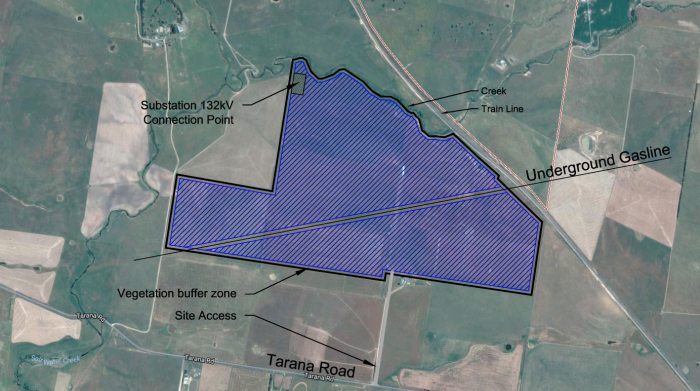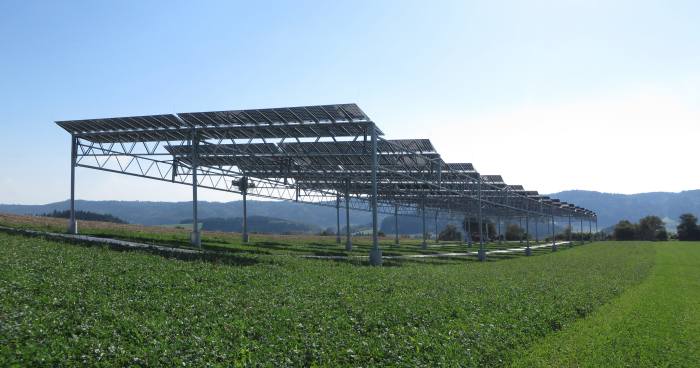
Site of the proposed Brewongle Solar Farm project
Photon Energy appears to be facing significant community opposition to the development of a large-scale solar farm near Bathurst.
The proposed Brewongle Solar Farm is a 129 MW project to be situated on 203 hectares of farmland approximately 7 kilometres from the regional city, and on the doorstep of the village of Brewongle.
Some of the region’s residents have expressed opposition to the solar farm primarily on the basis of aesthetics, impact on proptery values and that it would occupy what has been called prime agricultural land. So far, 365 people have signed an online petition, but it’s not clear how many of those signatories are locals.
Bathurst MP Paul Toole is backing residents in their fight and said he will push for “strategies that rule out building solar on prime agricultural land”.
Mr. Toole isn’t the only politician with an axe to grind regarding the project. Shooters, Fishers and Farmers Party’s Robert Brown called it “madness” in NSW Parliament earlier this month; making some interesting claims regarding the impact of Brewongle.
Mr. Smith favours so-called high‑efficiency, low‑emission (HELE) coal‑fired power stations proposed for the Hunter Valley, which he says would be better than “building dozens and dozens of Brewongles.”
Last week, Photon Energy managing director Michael Gartner responded to some of Mr. Brown’s criticisms.
“Sheep currently graze the treeless plains of Brewongle with very little protection. The solar panels we are proposing will provide a cool place to shade from sun and from extreme weather events,” said Mr. Gartner. ” We are working together with local farmers and agronomists to implement management plans over the life of the Brewongle solar farm that utilise these benefits and allow for the productive use of land for both harvesting energy and agricultural production.”
The situation highlights the importance of solar developers gaining social licence for their projects. Regardless of whether concerns are valid or not, once opposition gains a foothold, it can rapidly snowball. This can lead to projects being delayed and cost blowouts – or seeing them fail altogether.
The Brewongle battle also raises another important issue. While it’s exciting to see large-scale solar farms being developed in Australia as the nation moves towards a cleaner energy future; there are still so many rooftops in Australia’s towns and cities without solar panels, rooftops that could be generating electricity very close to the source of energy consumption.
Agrophotovoltaics : Solar + Agriculture
Australia isn’t the only country where agriculture and solar electricity generation are colliding at times, and research is being carried out to seek better co-existence between the two.
Germany’s Fraunhofer ISE has reported on an interesting agrophotovoltaics (APV) pilot project where solar panels have been installed on a small plot directly above crops. Fraunhofer ISE says the trial has been a “complete success”.
“Agrophotovoltaics (APV) has the potential to open up new space that is urgently needed for the PV expansion in Germany. At the same time APV can mitigate the conflicting interests between agriculture and open space PV systems for viable land,” said Professor Hans-Martin Henning.
The organisation claims agrophotovoltaics can increase land use efficiency by 60%.
The goal of the project is to develop APV system technology into a commercial product. As to how much the framing system is likely to cost compared to conventional ground mounting isn’t clear, nor is its potential suitability for various Australian agricultural scenarios.


 RSS - Posts
RSS - Posts



I think this is a complicated issue.
I would prefer that agricultural land be used for “wind farms” and agriculture, if sufficiently consistent wind energy is present, and that rooftops be used for photovoltaic panels, where feasible, rather than using agriculturally viable land, for “solar farms” instead of maximising the agricultural use of the viable land .
On the other hand, the use of frames as in the picture, appears to not significantly reduce the usability of the land for agriculture, and, has the (possible) advantage of the raised framework providing for the potential of (I do not know the correct, concise term for this) the mounting of machine driven panels that rotate on an axis to best follow the path of the sun, to maintain the optimal orientation to the sun, as the sun “follows its path across the sky”.
This smacks of wind turbine syndrome. No doubt a suitable financial “compensation” offer would make it all suddenly dissapear.
If they put these panels higher(as in the German example) ,it would be helpful not only for sheep. Cattle could graze,farmers could store their machinery, plough underneath,build pigpens underneath..everything. We get too much sun in Australia,and would not suffer from having areas if partly shaded land . cutting costs by putting the panels too low. That is what is happening there
Solar panels in prime agricultural zones are aesthetically unpleasing.
Far better to have solar panels situated on individual building roofs or in industrial estates.
For efficient and cost effective energy, I would suggest installing nuclear at existing coal fired power stations where they can easily be incorporated into the existing grid.